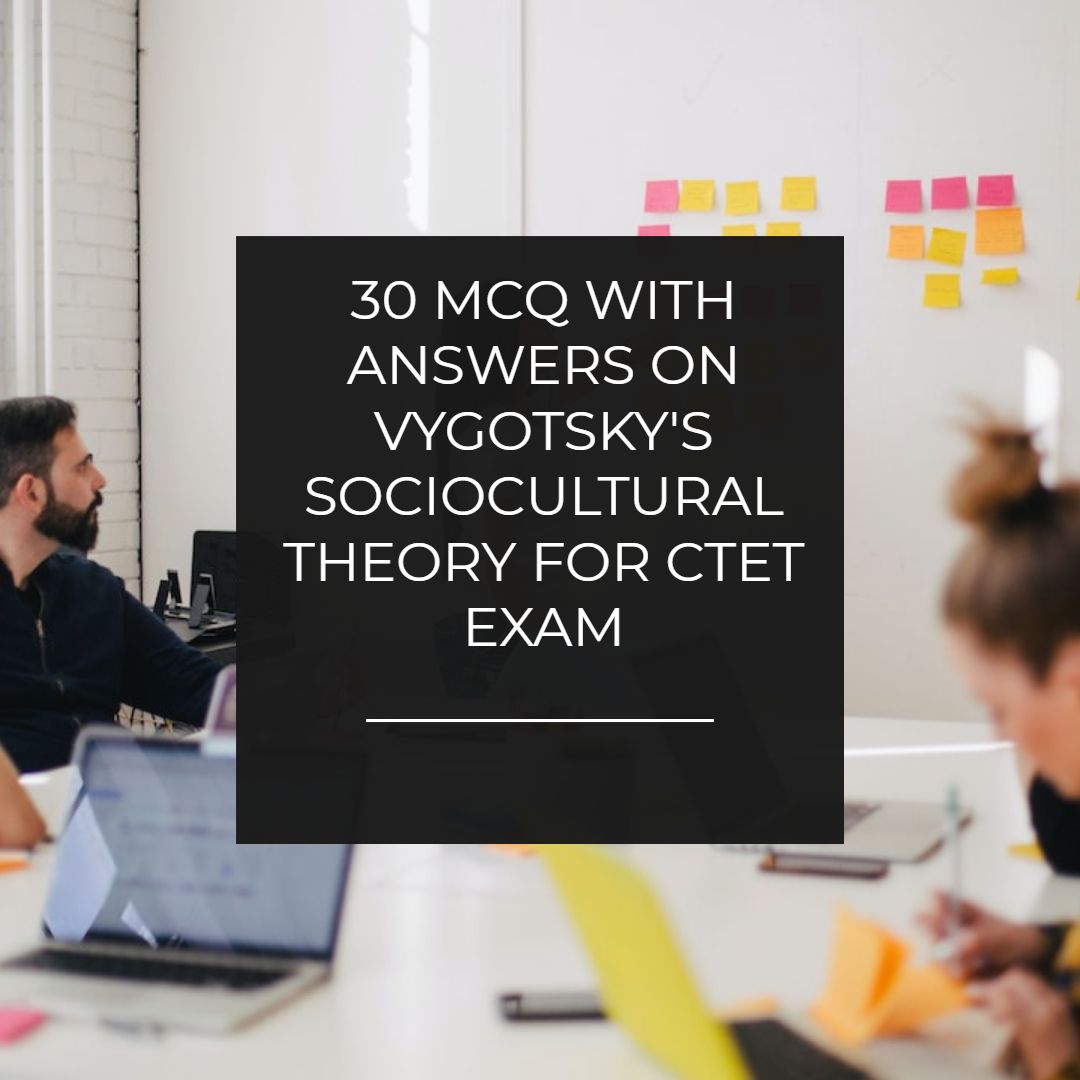30 MCQ with answers on Concept of inclusion and inclusive education for CTET Exam
30 MCQ with answers on Concept of inclusion and inclusive education for CTET Exam
Certainly! Here are 30 multiple-choice questions with answers on the concept of inclusion and inclusive education for the CTET (Central Teacher Eligibility Test) exam:
-
Inclusive education refers to:
a) Providing education exclusively for students with disabilities
b) Offering education in specialized schools for gifted students
c) Ensuring equal access to education for all students, including those with disabilities
d) Promoting competition and selective admissions in schools
Answer: c) Ensuring equal access to education for all students, including those with disabilities -
The primary goal of inclusive education is to:
a) Segregate students based on their abilities
b) Provide individualized instruction for each student
c) Foster an inclusive and supportive learning environment for all students
d) Focus only on academic achievement and test scores
Answer: c) Foster an inclusive and supportive learning environment for all students -
Inclusive education promotes:
a) Standardized instruction for all students
b) Uniformity and conformity in the classroom
c) Differentiation and personalized learning for diverse students
d) Exclusion of students with disabilities from mainstream classrooms
Answer: c) Differentiation and personalized learning for diverse students -
The concept of inclusion is based on the principle of:
a) Equality and social justice
b) Selectivity and exclusivity
c) Competition and ranking
d) Segregation and isolation
Answer: a) Equality and social justice -
Inclusive education recognizes that students with disabilities:
a) Should be educated separately from their peers
b) Require specialized instruction and separate classrooms
c) Have the right to be educated in regular classrooms with appropriate support
d) Are unable to benefit from mainstream educational settings
Answer: c) Have the right to be educated in regular classrooms with appropriate support -
Universal Design for Learning (UDL) is an approach that:
a) Adapts curriculum only for students with disabilities
b) Provides standardized instruction for all students
c) Tailors instruction based on individual student needs
d) Designs instruction to accommodate diverse learners from the outset
Answer: d) Designs instruction to accommodate diverse learners from the outset -
Individualized Education Programs (IEPs) are developed for students:
a) Excluded from inclusive classrooms
b) Identified as academically gifted
c) With specific learning disabilities
d) Receiving regular classroom instruction
Answer: c) With specific learning disabilities -
Inclusive education values and respects:
a) Homogeneity and conformity among students
b) Selective admission based on academic performance
c) Diversity and individual differences among students
d) Segregation of students based on ability levels
Answer: c) Diversity and individual differences among students -
The concept of “least restrictive environment” refers to:
a) Placing students with disabilities in segregated settings
b) Providing students with the most advanced learning resources
c) Ensuring that students with disabilities are included in regular classrooms to the maximum extent appropriate
d) Excluding students with disabilities from educational opportunities
Answer: c) Ensuring that students with disabilities are included in regular classrooms to the maximum extent appropriate -
The concept of inclusion is closely associated with:
a) Tracking and ability grouping
b) Standardized testing and ranking
c) Equity and social justice in education
d) Exclusion and segregation of students with disabilities
Answer: c) Equity and social justice in education -
Inclusive education emphasizes the importance of:
a) Labeling and categorizing students based on their
abilities
b) Separate schools and classrooms for students with disabilities
c) Collaboration and teamwork among teachers and support staff
d) Maintaining a rigid and inflexible curriculum
Answer: c) Collaboration and teamwork among teachers and support staff
-
Differentiation in inclusive classrooms refers to:
a) Teaching the same content in the same way to all students
b) Adapting instruction to meet the diverse needs of students
c) Excluding students with disabilities from participating in classroom activities
d) Providing additional support only to students with special needs
Answer: b) Adapting instruction to meet the diverse needs of students -
Inclusive education aims to create learning environments that are:
a) Homogeneous and uniform
b) Exclusive and selective
c) Diverse and inclusive
d) Segregated and isolated
Answer: c) Diverse and inclusive -
The role of a teacher in an inclusive classroom is to:
a) Focus solely on the academic needs of students
b) Segregate students based on their abilities
c) Provide support and accommodations to meet the diverse needs of all students
d) Exclude students with disabilities from classroom activities
Answer: c) Provide support and accommodations to meet the diverse needs of all students -
Assistive technology in inclusive classrooms refers to:
a) Specialized devices and tools that support students with disabilities in their learning
b) Advanced technology available only to academically gifted students
c) Technology that replaces the role of teachers in instruction
d) Technology used for tracking and monitoring student progress
Answer: a) Specialized devices and tools that support students with disabilities in their learning -
The concept of inclusive education is grounded in:
a) Exclusion and segregation of students with disabilities
b) Differentiation and individualization of instruction
c) The belief that all students can learn and participate in the same educational settings
d) The creation of separate classrooms and schools for students with disabilities
Answer: c) The belief that all students can learn and participate in the same educational settings -
Inclusive education promotes the idea that:
a) Academic achievement is the only measure of success in education
b) Students with disabilities should be isolated from their peers
c) Collaboration and cooperation are essential in the classroom
d) Students with disabilities cannot benefit from regular classroom settings
Answer: c) Collaboration and cooperation are essential in the classroom -
The term “differentiated instruction” refers to:
a) Providing the same instruction to all students regardless of their needs
b) Adapting instruction to meet the unique needs of each student
c) Segregating students based on their abilities and performance
d) Focusing only on the highest-achieving students in the classroom
Answer: b) Adapting instruction to meet the unique needs of each student -
Inclusive education benefits not only students with disabilities but also:
a) Students with high academic achievement
b) Teachers and support staff
c) Schools with selective admissions
d) Students with limited English proficiency
Answer: b) Teachers and support staff -
The concept of inclusion is based on the belief that:
a) Students with disabilities are a burden on the education system
b) All students deserve equal access to quality education
c) Students with disabilities should be educated separately from their peers
d) Academic achievement is the sole purpose of education
Answer: b) All students deserve equal access to quality education -
Inclusive education promotes:
a) Segregation and isolation of students
based on their abilities
b) Competition and ranking among students
c) Collaboration and cooperation among students with diverse abilities
d) Exclusive admission to specialized schools for students with disabilities
Answer: c) Collaboration and cooperation among students with diverse abilities
-
In an inclusive classroom, assessment strategies should:
a) Focus only on standardized testing
b) Be used to label and categorize students
c) Be flexible and accommodate diverse learning needs
d) Exclude students with disabilities from the evaluation process
Answer: c) Be flexible and accommodate diverse learning needs -
Inclusive education challenges the notion that:
a) Students with disabilities cannot learn in regular classrooms
b) Students with disabilities should be isolated from their peers
c) Academic achievement is the primary goal of education
d) Collaboration and teamwork are essential in education
Answer: a) Students with disabilities cannot learn in regular classrooms -
Inclusive education promotes the belief that:
a) Students with disabilities should be segregated from their peers
b) Students with disabilities are solely responsible for their learning
c) Students with disabilities have the right to participate in all aspects of school life
d) Students with disabilities should be provided with separate educational settings
Answer: c) Students with disabilities have the right to participate in all aspects of school life -
The Individuals with Disabilities Education Act (IDEA) is legislation that:
a) Excludes students with disabilities from educational settings
b) Promotes selective admission to schools based on academic performance
c) Ensures the right to free and appropriate education for students with disabilities in the least restrictive environment
d) Provides funding only for specialized schools for students with disabilities
Answer: c) Ensures the right to free and appropriate education for students with disabilities in the least restrictive environment -
Inclusive education requires:
a) Segregating students based on their abilities
b) Excluding students with disabilities from mainstream classrooms
c) Collaboration and partnership among educators, families, and communities
d) Focusing exclusively on academic achievement and test scores
Answer: c) Collaboration and partnership among educators, families, and communities -
Differentiated instruction in an inclusive classroom involves:
a) Providing the same instruction to all students regardless of their abilities
b) Segregating students based on their academic performance
c) Adapting instruction to meet the diverse needs of students
d) Limiting opportunities for students with disabilities to participate in classroom activities
Answer: c) Adapting instruction to meet the diverse needs of students -
Inclusive education requires educators to:
a) Label and categorize students based on their abilities
b) Focus primarily on the academic needs of students
c) Differentiate instruction and provide accommodations for diverse learners
d) Exclude students with disabilities from classroom activities
Answer: c) Differentiate instruction and provide accommodations for diverse learners -
Inclusive education aims to create classrooms that are:
a) Homogeneous and segregated
b) Exclusive and selective
c) Diverse and inclusive
d) Competitive and ranking-based
Answer: c) Diverse and inclusive -
The concept of inclusion is rooted in the belief that:
a) Academic achievement is the only measure of success in education
b) Students with disabilities should be educated separately from their peers
c) All students have the right to access quality education
d) Teachers should focus on the highest-achieving students in the classroom
Answer: c) All students have the right to access quality education
I hope these questions and answers on the concept of inclusion and
inclusive education will be helpful for your CTET exam preparation. Good luck!




As a prospective investor in Indian real estate consultants, I'm particularly interested in how these professionals, such as those at Address Advisors, leverage data science to enhance their market strategies. The integration of advanced analytics and data-driven insights can significantly impact investment decisions and property evaluations. I would appreciate any advice or recommendations on how Indian real estate consultants are utilizing these tools and how I can benefit from their expertise in this evolving field.